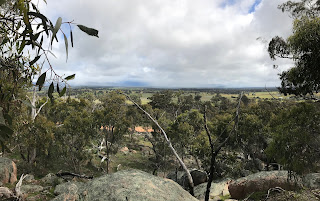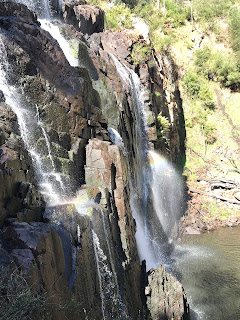Images from a four day trip across western Victoria to visit indigenous cultural centres, architecture and farming sites.
Rock art, Northern Gariwerd,
Djab Wurrung Country
 |
“Bunjil Shelter sits within the Gariwerd, a cultural landscape that supports
our people both physically and spiritually. Bunjil created our land, our people, the plants and animals, our religion and the laws by which we live. He is the leading
figure in our spiritual
life, essential in teaching
our young people
the importance of our laws and beliefs,”
Levi Lovett, local custodian, Parks Victoria.
|
 |
| Fencing required to protect this rock art site. |
Brambuk Cultural Centre
Gunditjmara Country
Mackenzie & Fish Falls Walk
Tower Hill Bush Tucker Tour with Jackie
 |
| Wattle seed baked into a loaf, uncovered by a plough in 1938 |
Bush Tucker - images only didn't take notes!
 |
| Warrigal Greens |
Spring babies. Animals reintroduced to the park in 1960s.
 |
| Robin Boyd designed Natural History Centre, 1967 |
 |
| Colleen helps a turtle across the road and to the lake. |
Winda-Mara Aboriginal Corporation Office in Heywood.
 |
| Image of original possum skin cloak in Museum Victoria from seven Gunditjmara elders from the Lake Condah Mission c. 1870s and new cloak make with Vicki Couzins |
Budj Bim Tour
 |
| Spring fed water way that cuts through the massive lava flow that is Budj Bim area. |
 |
| Opening always faces north-east towards kind weather |
 |
| Interior of stone houses package out with clay. |
 |
| Blackwood rafters, black wattle fill, clay, flowering bush on roof |
 |
| The Budj Bim Cultural Landscape, located in the traditional Country of the Gunditjmara Aboriginal people in south-eastern Australia, consists of three serial components containing one of the world’s most extensive and oldest aquaculture systems. The Budj Bim lava flows provide the basis for the complex system of channels, weirs and dams developed by the Gunditjmara in order to trap, store and harvest kooyang (short-finned eel – Anguilla australis). The highly productive aquaculture system provided an economic and social base for Gunditjmara society for six millennia. The Budj Bim Cultural Landscape is the result of a creational process narrated by the Gunditjmara as a deep time story, referring to the idea that they have always lived there. From an archaeological perspective, deep time represents a period of at least 32,000 years. The ongoing dynamic relationship of Gunditjmara and their land is nowadays carried by knowledge systems retained through oral transmission and continuity of cultural practice. |
 |
| Massacre Sculpture - Victoria |
 |
| Initiated by Regional Arts Victoria in partnership with Lake Condah Sustainability Development Project as part of a statewide initiative called ‘Fresh and Salty, artists Carmel Wallace and Vicki Couzens designed a sculpture with artistic references to the traditional use of water by Indigenous and European people. |
 |
| Remains, Lake Condah Mission |
 |
| End of tour with Braden, Veronica, Robyn, Kath, Me & Colleen |















































No comments:
Post a Comment